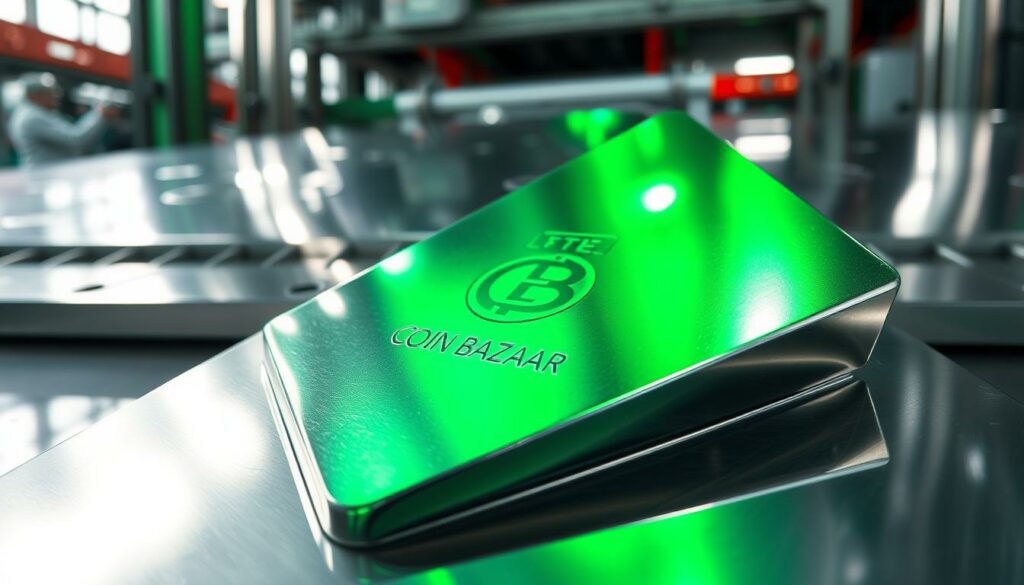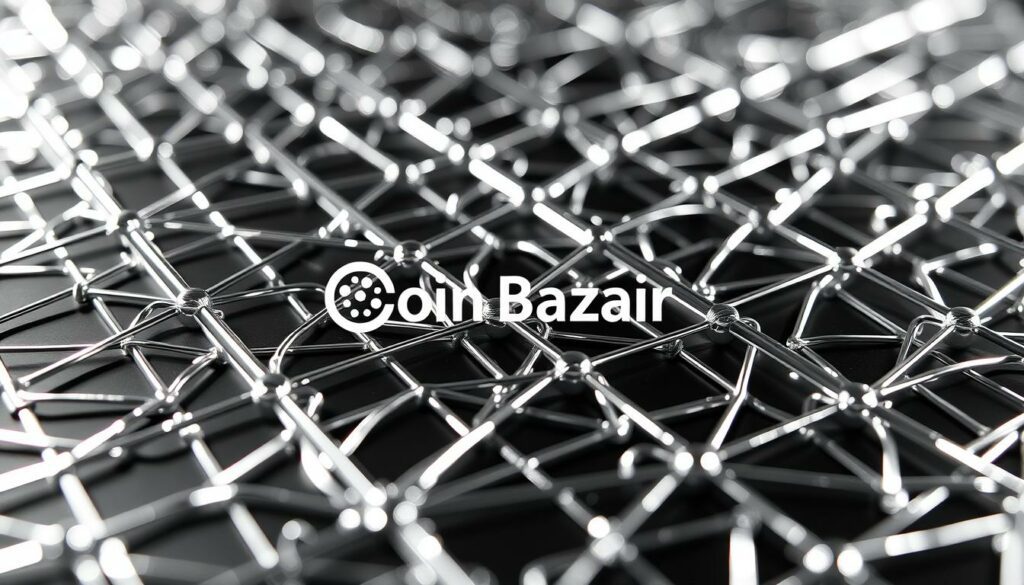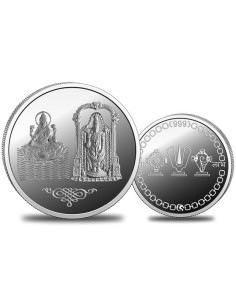Exclusive Deals & Trending Items


Precious Moments Personalised BIS Hallmarked New Born Baby Girl Silver Coin Of 10 Gram in 999 Purity / Fineness by ACPL
Shop NowYou might know that silver is more than just for jewelry and coins. It’s also key in many industrial uses.
There’s been a big increase in industrial demand for silver lately. This is mainly because of its role in green tech and sustainable energy.
As we move towards cleaner energy and greener practices, silver is playing a big part. It helps make these technologies work.
Key Takeaways
- The demand for silver is surging due to its use in green technologies.
- Silver plays a crucial role in sustainable energy solutions.
- The industrial demand for silver is expected to continue growing.
- Silver’s versatility makes it a valuable resource in various industries.
- The shift towards cleaner energy is driving the demand for silver.
The Green Metal Revolution
Did you know silver is key in the shift to greener tech? The world is moving towards sustainable practices, and silver demand is soaring. Its unique properties make it a valuable commodity in many industries.


Why Sustainable Industries Are Turning to Silver
Silver is becoming crucial in sustainable industries. It’s known for its conductivity, antimicrobial properties, and reflectivity. These qualities are vital for solar panels, electric vehicles, and other green tech.
For example, silver’s high thermal conductivity helps solar panels work better. They can turn sunlight into electricity more efficiently.
The Transition from Luxury to Industrial Necessity
The way we see silver is changing. It’s no longer just for jewelry and coins. Now, it’s a vital part of making many industrial and tech products.
This change is because of the growing need for green tech. Silver is becoming essential for sustainable development. It’s moving from a luxury item to an industrial necessity.
Silver: Properties That Make It Indispensable
Silver is versatile because of its amazing properties. It’s not just beautiful in jewelry, but also crucial in technology. Its uses in industry are impressive.
Silver’s unmatched conductivity and thermal features are key in many areas. It conducts electricity and heat well. This makes it perfect for electronics and green energy.
Unmatched Conductivity and Thermal Features
Silver leads all metals in electrical and thermal conductivity. This is vital for things like:
- Photovoltaic cells
- Electrical contacts and switches
- Conductive pastes for printed electronics
Comparison with Other Conductive Metals
Compared to copper, silver is better at conducting. But, it’s pricier, which might limit its use.
| Metal | Conductivity (S/m) | Cost (Relative) |
|---|---|---|
| Silver | 6.3 x 10^7 | High |
| Copper | 5.96 x 10^7 | Moderate |
| Gold | 4.52 x 10^7 | Very High |
Antimicrobial and Reflective Capabilities
Silver’s antimicrobial properties are a big plus in healthcare and products. It’s used in wound care, medical tools, and even clothes. It stops bacteria and microbes from growing.
“Silver has been used for centuries for its antimicrobial properties, and modern technology has enabled us to harness this power in various innovative ways.”


Silver is durable and conducts well, making it great for many uses. It lasts a long time, keeping products working longer.
In summary, silver’s unique qualities make it essential in many fields. As tech advances, silver’s demand will grow. This is due to its conductivity, antimicrobial abilities, and lasting nature.
Solar Energy: Silver’s Brightest Application
The solar energy industry uses a lot of silver, thanks to the need for photovoltaic cells. As we move towards renewable energy, silver’s role in solar energy is key.
Photovoltaic Cell Manufacturing Requirements
Photovoltaic cells turn sunlight into electricity, and they need silver for this. Silver’s high electrical conductivity makes it perfect for the electrodes in photovoltaic cells. This is why silver is in high demand for solar panels.
Silver Paste Technology Advancements
New silver paste technologies have boosted photovoltaic cell efficiency. Silver paste helps create the grid lines on solar cells, which carry electricity. Better silver paste means better conductivity and less silver use.
Efficiency Improvements Through Silver
Using silver in photovoltaic cells has greatly improved their efficiency. By fine-tuning silver use, makers can get more electricity from the sun.
Consumption Metrics Per Gigawatt
How much silver is used per gigawatt of solar energy depends on the tech. New tech has cut silver use per unit of electricity, making solar energy more affordable and green.
The solar energy market is growing, and so is the need for silver. Knowing how silver is used in solar cells and the progress in silver paste tech is vital for the solar industry.
Electric Vehicles Driving Silver Demand
The world is moving towards electric vehicles, and silver demand is soaring. You might wonder how silver fits into electric vehicles.
Critical Components Requiring Silver
Silver is key in electric vehicles. It’s great for electrical contacts and switches because of its high conductivity. It’s also used in high-performance conductive pastes for batteries and other parts.
Battery Technology and Silver Integration
Battery tech is vital for electric vehicles, and silver is crucial here. It boosts battery performance and efficiency. Here are some stats on silver in EV batteries:
| Component | Silver Usage | Benefits |
|---|---|---|
| Electrical Contacts | High | Improved Conductivity |
| Battery Conductive Pastes | Moderate to High | Enhanced Performance |
Charging Infrastructure Requirements
The rise of electric vehicles also boosts charging infrastructure needs. Silver is used in fast-charging connectors and other parts needing high conductivity.
Indian EV Market Growth Projections
The Indian electric vehicle market is set to grow fast. It’s expected to grow over 20% from 2023 to 2030. As it grows, so will the need for silver in EVs.
Electronics and 5G: The Silver Connection
Silver is key in the 5G and IoT world because of its ability to conduct electricity. As tech gets better, more silver is needed in electronics.
Miniaturization Trends Increasing Silver Usage
As gadgets get smaller and more detailed, silver becomes more important. It’s needed for its great conductivity and heat handling. Silver leads in this miniaturization trend.
Key benefits of silver in miniaturized electronics include:
- Enhanced performance
- Increased efficiency
- Reliability in high-frequency applications
India’s Electronics Manufacturing Ecosystem
India is becoming a big name in making electronics. The country’s efforts to grow its electronics sector are opening up new chances for silver use.
Semiconductor Dependencies
The semiconductor industry is key to India’s electronics goals. Silver is crucial here because of its excellent conductivity and dependability.
IoT Device Proliferation
More IoT devices mean more silver needed in India’s electronics. As IoT tech spreads, silver’s role in devices will likely increase.
| Industry | Silver Usage | Growth Drivers |
|---|---|---|
| Electronics | High | 5G, IoT, Miniaturization |
| Semiconductors | Very High | Performance, Efficiency |
| IoT Devices | High | Device Proliferation |
In conclusion, silver’s role in electronics, especially with 5G and IoT, is growing. As India builds its electronics sector, silver demand will likely rise.
Healthcare and Biomedical Applications
Silver is used in many ways in medicine. It’s known for its ability to fight off harmful bacteria. This makes it a key part of many healthcare products.
Silver Nanoparticles in Medical Devices
Silver nanoparticles are becoming more common in medical tools. They help keep medical equipment and implants clean by stopping bacteria from growing. This reduces the chance of infections.
Water Purification Technologies
Silver is also used to clean water. Its power to kill bacteria makes it perfect for water filters. This ensures the water we drink is safe.
Traditional Ayurvedic Uses in India
In India, silver has been used in Ayurvedic medicine for ages. People believe it boosts the immune system and improves health.
Pandemic-Related Demand Surge
The COVID-19 pandemic has made silver products more popular. This includes antimicrobial coatings and protective gear. It shows how important silver is in keeping us healthy.
Global Silver Supply Chain Dynamics
The demand for silver is growing, making it key to understand the global supply chain. We must look at the factors that affect silver supply, from mining to recycling.
Primary Production Centers Worldwide
Silver is mined in many places, with Mexico, Peru, and China leading the way. The global silver production is concentrated in a few key regions. This makes supply chains sensitive to political issues.
| Country | Production (Tons) | Percentage of Global Total |
|---|---|---|
| Mexico | 6,300 | 23% |
| Peru | 4,100 | 15% |
| China | 3,600 | 13% |
Recycling Potential and Urban Mining
Recycling is crucial in the silver supply chain, meeting a big part of demand. Urban mining, or getting silver from old electronics, is also growing.
Environmental Impact of Extraction
Getting silver can harm the environment, like polluting water and destroying habitats.
“The environmental footprint of silver mining is a concern that needs to be addressed through sustainable practices.”
Trade Flow Patterns to India
India is a big user of silver, with most coming from imports. Knowing how silver moves in trade is vital for those in the Indian market.
India’s Strategic Position in the Silver Market
The silver market in India is a mix of industrial and traditional uses. As India grows, so does its need for silver. This is because silver is used in many industrial ways.
Consumption Patterns: Industrial vs. Traditional
In India, silver is used in two main ways. It’s used in electronics and solar panels for industrial needs. It’s also used in jewelry and ornaments for traditional purposes.
There’s a big move towards using silver for industrial needs. This is because of India’s focus on renewable energy and making electronics. But, the demand for traditional uses like jewelry stays high, especially during festivals and weddings.
Import Dependencies and Vulnerabilities
India relies a lot on silver imports to meet its needs. This makes the country sensitive to changes in global silver prices and supply issues.
Domestic Silver Jewelry Industry
The silver jewelry industry in India is a big user of silver. It helps meet local demand and also earns foreign exchange through exports.
Government Policies and Tariff Structures
Government policies and tariffs greatly affect the silver market in India. Changes in import duties can change how much manufacturers make and what consumers pay.
| Category | Impact of Government Policies |
|---|---|
| Import Duties | Higher duties can make things more expensive for buyers and cut into manufacturers’ profits. |
| Export Incentives | Help for exporting silver jewelry can make the local industry more competitive worldwide. |
| Industrial Support | Support for silver in industry can boost demand and encourage local making. |
In conclusion, India’s role in the silver market is shaped by its use patterns, import needs, and government actions. Knowing these factors is key for those in the silver market.
Silver Price Trends and Market Analysis
The price of silver is influenced by many things. These include industrial demand, global events, and market speculation. Knowing these trends is key to making smart choices in the silver market.
Historical Performance During Green Transitions
Silver prices have been strong during green transitions. The world’s move towards renewable energy and sustainable tech has boosted silver demand. This has led to higher prices.
For example, solar energy’s growth has increased silver use. This is because silver is great at conducting electricity.
“The increasing adoption of renewable energy sources and electric vehicles is expected to drive the demand for silver, potentially leading to higher prices in the long term.”
Industrial Demand Impact on Pricing
Industrial demand is a big factor in silver prices. The rise in silver use in electronics, solar panels, and electric vehicles has pushed prices up. Silver is also used in healthcare and water purification.
| Sector | Silver Consumption | Impact on Price |
|---|---|---|
| Solar Energy | High | Significant |
| Electronics | Moderate | Notable |
| Electric Vehicles | Increasing | Growing |
Seasonal Variations in Indian Markets
In India, silver prices can change with the seasons. This is especially true during festivals when more silver jewelry and coins are bought. Prices often go up during these times because of the increased demand.
Global Factors Affecting Local Prices
Global events like economic policies, trade wars, and currency changes can also affect silver prices. For example, a shift in global economic policies can cause silver prices to swing. This can impact prices in local markets too.
When looking at silver price trends, it’s important to consider both past data and current market conditions. Understanding these factors helps you make better choices in the silver market.
Investment Options for Indian Silver Enthusiasts
If you’re an Indian investor, you might be looking into different ways to invest in silver. Silver is special because it’s used in both industrial and precious metal ways. This makes it a great choice for many investment paths.
Physical Silver: Coins, Bars, and Artifacts
Buying physical silver is a classic and favorite choice. You can get silver coins, bars, and other items from approved sellers or banks. Physical silver is something you can hold, but it needs safe storage.
Financial Instruments: ETFs and Funds
If you prefer not to hold physical silver, you can look into Exchange-Traded Funds (ETFs) and silver mutual funds. These options let you invest in silver without needing to store it physically.
Digital Silver and Blockchain Options
Now, you can also invest in digital silver through online platforms. This digital silver is backed by real silver. Blockchain technology makes these deals safe and clear.
Tax Implications for Different Investment Forms
It’s important to know how taxes work for your silver investments. For example, selling physical silver might lead to capital gains tax. But, ETFs could be taxed differently. Talking to a tax expert can help you understand these rules better.
By mixing physical and financial silver investments, you can make your portfolio more varied. Here are some things to think about:
- Think about what you want to achieve with your investment and how much risk you can take.
- Look at how easy it is to sell each investment option.
- Check the costs linked to each investment type.
Silver Versus Gold and Other Precious Metals
Silver is gaining importance, unlike gold, in many industrial uses. It stands out because it serves as both an investment and an industrial metal. This makes silver unique compared to other precious metals.
Industrial Utility Comparison
Silver is key in electronics and solar energy because of its excellent conductivity and thermal properties. It’s cheaper and more efficient than gold, which is also used in electronics but is pricier.
Investment Performance Metrics
When looking at silver and gold as investments, their volatility and demand are key. Silver is more volatile, offering bigger returns but also bigger risks.
Cultural Significance in Indian Context
In India, silver is deeply valued for jewelry and decorations. This cultural importance can sway investment choices, making silver popular during special times.
Portfolio Allocation Strategies
Adding silver to your investments can diversify your portfolio. It can help reduce risks tied to other assets, especially when the economy is down.
Key Considerations:
- Industrial demand for silver
- Investment potential compared to gold
- Cultural significance in India
- Diversification benefits in portfolios
Challenges in the Silver Supply Chain
The demand for silver is growing, but the supply chain faces big challenges. The need for silver in solar panels, electric vehicles, and electronics is high. This demand puts a lot of pressure on the supply chain.
Mining Constraints and Resource Depletion
The silver supply chain relies a lot on mining. But mining faces challenges like finding new resources and dealing with environmental rules. It takes a long time and a lot of money to find and open new mines.
Mining constraints include geological challenges, environmental regulations, and social opposition. For example, many mining sites are in sensitive areas. This makes it hard to get the needed permits.
Technological Substitution Threats
The silver supply chain also worries about new technologies. New tech could make materials that replace silver. This could lower the demand for silver.
Price Volatility Factors
Silver prices can change a lot. This is because of market speculation, currency changes, and shifts in demand. This makes it hard for producers and buyers to guess future prices. It affects their investment plans.
Geopolitical Supply Risks
Politics also affect the silver supply chain. Countries that mine silver often face political issues or changes in rules. For example, new mining laws or export limits can cut silver supply.
“The silver market is subject to a complex array of factors that can affect its supply chain, from mining constraints to geopolitical risks.”
India’s Green Energy Transition and Silver
India is moving fast towards green energy, and silver demand is rising. Silver is key in green tech, especially in solar and electronics.
National Solar Mission Requirements
The National Solar Mission is key for India’s green energy push. It aims to boost solar energy use. Silver is vital for making solar cells that turn sunlight into electricity.
Manufacturing Self-Reliance Initiatives
India’s push for making things at home is also boosting silver demand. By making solar panels and renewable gear at home, India is less dependent on imports. This is expected to increase silver demand in manufacturing.
State-Level Renewable Policies
State policies are crucial for green energy growth. Many states in India support solar and renewable energy. These policies are opening up new silver demand opportunities.
Employment Generation in Silver-Dependent Industries
The growth of silver-based industries is creating jobs. As renewable energy grows, so do jobs in making, installing, and maintaining. This trend will keep growing as India’s green energy push continues.
| Industry | Silver Demand | Growth Rate |
|---|---|---|
| Solar Energy | High | 15% |
| Electronics | Moderate | 10% |
| Renewable Energy Equipment | High | 12% |
In conclusion, India’s green energy shift is boosting silver demand. As India promotes renewable energy, silver demand is expected to rise.
Emerging Technologies Boosting Silver Consumption
Emerging technologies are making silver more in demand. Its unique properties and versatility are key. As new technologies come along, silver’s demand is expected to go up.
Printed Electronics Advancements
Printed electronics are a big reason for the rise in silver demand. Silver’s high conductivity is perfect for printed circuit boards and other parts. With printed electronics getting better, silver use is set to grow more.
Energy Storage Innovations
Advances in energy storage, especially in batteries, are also boosting silver demand. Silver is used in various battery components because of its high thermal conductivity. This helps improve battery performance. As we move towards renewable energy, silver’s role in efficient storage solutions will increase.
Smart City Infrastructure Requirements
The growth of smart city infrastructure is also driving silver demand. Silver is used in smart city applications like energy-efficient buildings and smart transport systems. As more cities go smart, silver demand will likely rise.
Research Developments in Indian Institutions
Indian institutions are key in researching new silver-based technologies.
“The research in Indian institutions is paving the way for innovative applications of silver in various emerging technologies.”
This research is boosting India’s tech capabilities and increasing silver demand.
As new technologies keep evolving, silver demand will likely grow. It’s important for investors and industries to understand these trends.
The Environmental Footprint of Silver Production
The demand for silver in green tech raises big questions about its environmental impact. It’s key to grasp the ecological effects of making silver.
Mining Impact Assessment
Silver mining has big environmental effects. It can harm habitats, pollute water, and contaminate soil. We need to look at these impacts and how mining tries to lessen them.
- Habitat destruction due to land excavation
- Water pollution from chemical runoff
- Soil contamination affecting local ecosystems
Recycling and Circular Economy Potential
Recycling silver is a big chance to cut down its environmental impact. By reusing silver, we need less new mining. This lowers the harm to our planet.
Sustainable Sourcing Initiatives
Many groups are starting sustainable sourcing initiatives. They make sure silver is mined and processed right. They work with suppliers to follow the best practices.
Certification and Compliance Standards
Certification and standards are key for green silver production. The Responsible Minerals Initiative checks and certifies mines that follow strict rules.
Knowing silver’s environmental impact and supporting green practices helps. It makes the supply chain better for our planet.
Conclusion: Silver’s Crucial Role in a Sustainable Future
As the world moves towards a sustainable future, silver is becoming key. It will be important in green technologies because of its great conductivity and other special properties. These include its ability to handle heat and fight off germs.
The need for silver in industries is growing fast. This is because of its use in solar power, electric cars, gadgets, and health care. Silver is both useful in industry and a good investment, making it appealing for the green movement.
In India, the country’s role in the silver market is getting stronger. With more demand for green tech, silver’s use will likely grow. This will boost growth and bring new ideas in various fields.
Looking ahead, silver’s role in making our world more sustainable is clear. Its special qualities and increasing demand make it a key player in the green shift.



















